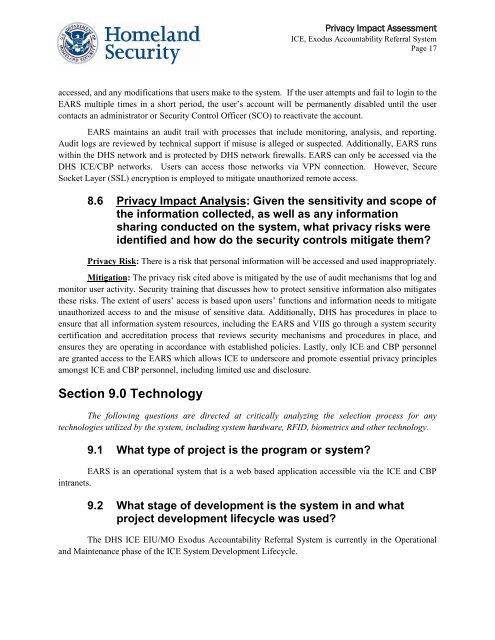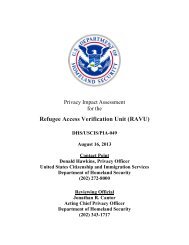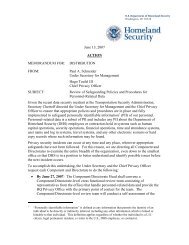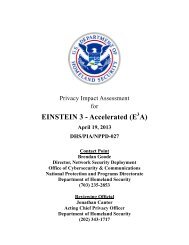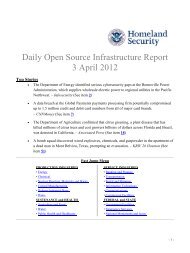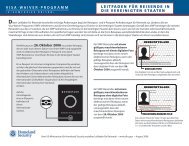Exodus Accountability Referral System (EARS) - Homeland Security
Exodus Accountability Referral System (EARS) - Homeland Security
Exodus Accountability Referral System (EARS) - Homeland Security
Create successful ePaper yourself
Turn your PDF publications into a flip-book with our unique Google optimized e-Paper software.
Privacy Impact Assessment<br />
ICE, <strong>Exodus</strong> <strong>Accountability</strong> <strong>Referral</strong> <strong>System</strong><br />
Page 17<br />
accessed, and any modifications that users make to the system. If the user attempts and fail to login to the<br />
<strong>EARS</strong> multiple times in a short period, the user’s account will be permanently disabled until the user<br />
contacts an administrator or <strong>Security</strong> Control Officer (SCO) to reactivate the account.<br />
<strong>EARS</strong> maintains an audit trail with processes that include monitoring, analysis, and reporting.<br />
Audit logs are reviewed by technical support if misuse is alleged or suspected. Additionally, <strong>EARS</strong> runs<br />
within the DHS network and is protected by DHS network firewalls. <strong>EARS</strong> can only be accessed via the<br />
DHS ICE/CBP networks. Users can access those networks via VPN connection. However, Secure<br />
Socket Layer (SSL) encryption is employed to mitigate unauthorized remote access.<br />
8.6 Privacy Impact Analysis: Given the sensitivity and scope of<br />
the information collected, as well as any information<br />
sharing conducted on the system, what privacy risks were<br />
identified and how do the security controls mitigate them?<br />
Privacy Risk: There is a risk that personal information will be accessed and used inappropriately.<br />
Mitigation: The privacy risk cited above is mitigated by the use of audit mechanisms that log and<br />
monitor user activity. <strong>Security</strong> training that discusses how to protect sensitive information also mitigates<br />
these risks. The extent of users’ access is based upon users’ functions and information needs to mitigate<br />
unauthorized access to and the misuse of sensitive data. Additionally, DHS has procedures in place to<br />
ensure that all information system resources, including the <strong>EARS</strong> and VIIS go through a system security<br />
certification and accreditation process that reviews security mechanisms and procedures in place, and<br />
ensures they are operating in accordance with established policies. Lastly, only ICE and CBP personnel<br />
are granted access to the <strong>EARS</strong> which allows ICE to underscore and promote essential privacy principles<br />
amongst ICE and CBP personnel, including limited use and disclosure.<br />
Section 9.0 Technology<br />
The following questions are directed at critically analyzing the selection process for any<br />
technologies utilized by the system, including system hardware, RFID, biometrics and other technology.<br />
9.1 What type of project is the program or system?<br />
<strong>EARS</strong> is an operational system that is a web based application accessible via the ICE and CBP<br />
intranets.<br />
9.2 What stage of development is the system in and what<br />
project development lifecycle was used?<br />
The DHS ICE EIU/MO <strong>Exodus</strong> <strong>Accountability</strong> <strong>Referral</strong> <strong>System</strong> is currently in the Operational<br />
and Maintenance phase of the ICE <strong>System</strong> Development Lifecycle.


